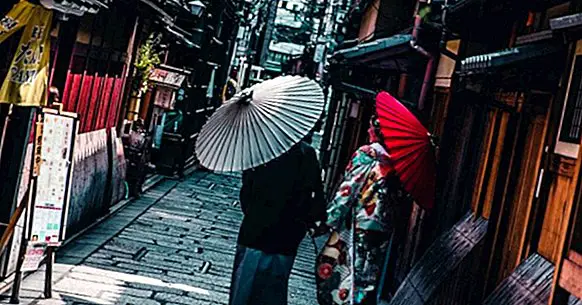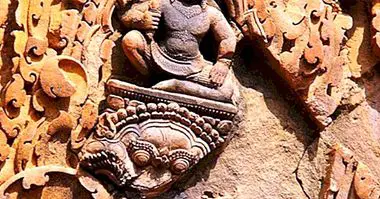The 10 most interesting Japanese legends
Throughout the world there are a lot of myths and traditions, coming from the wide diversity of cultures that have been (and still are) throughout history. One of the mythologies that most often fascinates the Western world is the Japanese, which generates great interest and has become popular over time.
They are multiple the Japanese myths and legends through which the ancient inhabitants of the island tried to give an explanation to the world that surrounded them, and that continue to be the object of inspiration for multiple writers and artists.
That is why throughout this article we are going to make a brief collection of ten Japanese legends, short or more complex, proof of the cultural richness of this region of Asia . These allow us to see the traditional perspective of the Japanese people regarding subjects as diverse as love or the origin of elements of nature or the geography of their territory.
- Related article: "10 short Mexican legends based on folklore"
A selection of the most popular Japanese legends
Then we leave you with a brief collection of ten highly known and relevant Japanese legends, which explain to us from Japanese folklore the reason for the existence of elements of nature or stories of love or terror based on gods, creatures and spirits typical of its mythology
1. The bamboo cutter and the princess of the moon
One of the best known mythological figures of Japan is the Kaguya-hime, on which there are numerous legends. Among them we can see how some of its legends refer to some of the most important geographical elements of the island, such as Mount Fuji. One of them is the following one, that also incorporates references to the reason of the fog that covers this mountain (in reality a volcano that still shows certain activity).
According to legend there was once a humble old couple who had never been able to have children despite wanting it deeply. To live, the couple depended on the collection of bamboo and its use to make different articles . One night, the old man went into the forest to cut and collect bamboo, but suddenly he noticed that one of the samples he had cut shone in the light of the moon. After examining the stem, he found inside it a small girl, a few centimeters in size.
Since his wife and he had never been able to have children, the man took her to his home, where the couple would give him the name of Kaguya and decide to raise her as his daughter. In addition, the branch from which the girl had left eventually began to generate gold and precious stones, making the family rich.
The girl grew with the passage of time, becoming a beautiful woman. Her beauty would be such that she would begin to have numerous suitors, but she refused to marry any. The news about her beauty reached the ears of the emperor , who intrigued asked him to come to his presence, to which Kaguya-hime refused. Before the refusal the emperor would come in person to visit her, falling quickly in love with her and pretending to take her with him to his castle, to which the young woman would also refuse. From then on the emperor would continue to maintain communication with Kaguya-hime through numerous letters.
One day, the young woman spoke with her adoptive father about the reason for her denials, as well as the reason why each night she spent hours looking at the sky: she came from the Moon, her home, of which she was a princess and to which I was destined to return in a short time. Distressed, the parents told the emperor, who sent guards to try to prevent the woman from being returned to the moon.
Despite the security measures, a night of full moon a cloud descended from the Moon with intention to take it. Before leaving again to your home, however, Kaguya-hime said goodbye to her parents and left behind a love letter for the emperor , along with a bottle in which he left to the second the elixir of eternal life. The letter and the bottle were given to the emperor, who decided to take them to the highest mountain and create a bonfire. There, once the Moon came out, the emperor threw the letter and elixir into the fire, generating a smoke that would rise to the place where his beloved had left. That mountain is Mount Fuji-yama, and even today we can see in its summit the smoke from the bonfire of the emperor.
- Maybe you're interested: "10 Irish legends full of mythology and folklore"
2. The red thread of destiny
One of the best known love legends of the Japanese people is the one that tells us about the red thread of destiny, which starts from our little finger (which is irrigated by the same artery as the middle finger, something that ended up associating the first with the transmission of feelings) to be tied to that of another person to whom we are destined to know, maintaining a deep bond with them. These are legends that usually talk about loves that are predisposed to happen . Although there is more than one legend based on this concept, the most famous is the one that follows.
Legend has it that many years ago, an emperor received the news that there existed in his kingdom a powerful sorceress capable of seeing the red thread of destiny. The emperor ordered her to be brought before his presence, asking him to help him find the one who should be his wife.
The sorceress accepted and began to follow that thread, taking them both to a market. There, the sorceress would stop in front of a plebeian , a poor peasant who sold products in the market with her baby in her arms. Then, the sorceress told the emperor that there ended his thread. However, and seeing that she was facing a peasant of great poverty, the emperor thought that the sorceress was mocking and pushing the peasant, causing her baby to fall and a big wound on her head. After ordering the execution of the sorceress, the emperor returned to the palace.
Many years later and guided by his advisers, the emperor decided to marry the daughter of one of the most important generals of the country, although he would not see her until the day of the wedding. That day, seeing her face for the first time, she discovered that her future wife had a scar on her head, the result of a fall as a baby. Evidently: just as the sorceress had predicted, the woman who was going to share her life was the peasant's baby.
3. Sakura and Yohiro
Another of the most well-known legends explains to us from a love story the origin and flowering of One of the most beautiful and emblematic trees in Japan: the cherry tree . The story is the following.
The legend says that a long time ago, in a time of great warlike conflicts, a forest full of beautiful trees existed. All of them had an abundant and florid glass, and such was their beauty and consolation that they offered no fighting to take place in the forest. All but one: there was a young specimen that never bloomed, and nobody approached because of its dry appearance and decrepit appearance.
One day a fairy, seeing the situation of the tree, was moved and decided to help him: he proposed to the tree to cast a spell thanks to which he could feel the same as a human heart for twenty years, hoping that the experience of emotion would make him flourish . Also during this period could become a human being at will. However, if after those years he could not recover and flourish, he would die.
After accepting the spell and receiving the ability to feel and transform, the tree began to enter the world of men. What he found was war and death, something that made him shun them for long periods. The years went by and the tree was losing hope. However, one day when he became human, the tree was found in a stream to a beautiful young woman, who treated him with great kindness. It was about Sakura, with whom After helping her bring water to her home, she spent a long conversation about the state of war and the world.
When the girl asked her name, the tree managed to babble Yohiro (hope). They were seen every day, a deep friendship emerged. This friendship would end little by little becoming deeper, until it became love. Yohiro decided to tell Sakura how he felt about her, along with the fact that it was a tree about to die. The young girl fell silent.
When it was not long before the twenty years of the spell were over, Yohiro became a tree again. But although I did not expect it, Sakura arrived and hugged him, telling him that she also loved him . In it the fairy appeared again, offering young Sakura two options: to remain human, or to merge with the tree. Sakura chose to merge forever with Yohiro, something that gave rise to the flowers of the tree: the cherry tree. From that moment your love can be seen during the flowering of the cherry tree.
4. The legend of Yuki Onna
Yuki-Onna is a yokai or spirit, of feminine form, that appears during the nights of snow for to feed on the vital energy of those who get lost in their territory and turn them into frozen statues . This being is part of several legends, representing death by freezing. Among them, one of the most outstanding is the one that follows.
Legend has it that one day two young lumberjacks and carpenters, Mosaku and Minokichi, were returning home from the forest when they were immersed in a snowstorm. Both, teacher and student respectively, took refuge in a cabin and soon after they fell asleep.
However, at that moment a blast opened the door violently, entering with her a woman dressed in white who, approaching the master Mosaku, absorbed his vital energy and froze him, something that killed him on the spot. The young Minokichi was paralyzed, but seeing his youth Yuki-Onna decided to forgive him in exchange for never revealing what happened , in which case he would kill him. The young man agreed.
A year later, Minokichi met and later married a young woman named O-Yuki, with whom he had children and a happy relationship. One day, the young man decided to tell his wife what he had experienced. At that moment O-Yuki was transformed, discovering herself as Yuki-Onna and ready to kill Minokichi after having rotated this pact. But nevertheless at the last moment he decided to forgive him when he considered him a good father , and after leaving his children in Minokichi's care, he left home to never return.
5. Shita-kiri Suzume: the sparrow of the cut tongue
Some ancient Japanese legends have the form of a fable that shows us the price of greed and the virtue of kindness and moderation. One of them is the legend of the sparrow of the cut tongue.
This story tells us how a noble and benevolent old man went to the forest to cut wood, to find a wounded sparrow. The old man took pity on the bird, taking the animal to his house to take care of it and feed it. The old man's wife, a greedy and greedy lady, did not support him, but that did not stop him. One day when the old man had to return to the forest, the woman left the wounded bird alone, which found cornmeal that ended up being eaten. When he returned, seeing that he had finished it, he got angry and cut the sparrow's tongue before expelling him from the house.
Later, when the old woodcutter returned and found out what had happened, he went looking for him. In the forest and with the help of some sparrows, the old man found the inn of the sparrows , where he was welcome and could say hello to the one he had saved. When saying goodbye, the sparrows gave him the choice as a gift of gratitude between two baskets, one large and one small.
The old man chose the little one, to discover once at home that hid a treasure of great value. His wife, after knowing the story and that there was another basket, went to the inn and demanded the other basket for her. They gave it to him with the warning that he did not open it until he got home . Despite this the old man ignored them, opening the basket in the mountain. This caused that what she saw in her interior were diverse monsters, something that frightened her in such a way that she tripped and fell down the mountain.
6. Amemasu and the tsunamis
Japan is located in a territory that, due to its geological situation and since ancient times, is frequently punished by numerous natural catastrophes such as earthquakes or tsunamis. In this sense we can also find myths and legends that try to explain why these phenomena. An example is found in the legend of Amemasu, which tries to explain why tsunamis.
Legend has it that in ancient times there was a gigantic yokai (a term that refers to a set of supernatural spirits of great power that make up much of Japanese mythology) in the form of a whale called Amemasu, which inhabited Lake Mashu in such a way that its huge body blocked the passage of the waters of the Pacific Ocean.
One day, a small deer approached the lake in order to quench his thirst. At that moment the gigantic yokai jumped to eat the deer, swallowing it in the act. The little deer, inside Amemasu, wept. He cried in such a way that his tears, of an exceptional purity, They pierced the stomach of the beast with such force that a hole was opened in the guts of Amemasu , killing him while letting the deer go.
The death of the yokai was seen by a bird that passed through the area, which would run to the different villages to warn of the danger that the death of the being supposed, being his body that slowed down the waters of the ocean. But nevertheless, With the exception of the Ainu, who fled to high territories, most of the island's inhabitants were curious and they went to the lake in order to see what happened.
Once there and seeing the huge body of the yokai decided to eat it without any respect. But that had serious consequences: after being devoured Amemasu's body had disappeared what blocked the waters of the Pacific, which at the same time the contained waters flooded the area and killed all those present .
This would cause the first tsunami, which would only leave the Ainu alive, who heeded the bird's warnings. It is said that after that, the rest of the tsunamis that devastate Japan are caused by the wrath of the spirit before the crimes directed to the sea animals.
7. Teke-teke
An urban legend of terror based on modern times, the story of Teke-teke tells us how a shy young woman who transformed herself into a spirit that keeps prowling the country's train stations .
The legend tells how a shy and fragile young girl was the victim of school bullying. The young woman received constant humiliations and vexations, without being able to defend herself. One day, the young woman was absorbed in her thoughts and waiting for a train to return home when some of her torturers spotted her.
They took a cicada from the road, throwing it on their backs. When the animal began to sing on her back, the girl got scared and fell on the tracks , in such a way that just a train passed over: the girl died, being split in two by the train.
From then on it is said that during the nights it is possible to see the upper part of her body crawling with her nails, looking for her other half in a desperate and angry way. If he finds someone, he asks where his legs are, and sometimes he attacks them with his claws (getting to push other people to the tracks and even kill them and transform them into creatures like her).
8. Yamaya no Orochi
Japanese legends often include the presence of various Shinto gods, as well as great deeds and the obtaining of treasures. An example of these is the legend of the dragon Yamaya no Orochi .
The legend tells us how in the beginning of time humanity lived in the same land with deities and beasts, being in balance and helping each other. But nevertheless, There came a time when the god Izanagi entered into conflict with his wife Izanami , something that destroyed the balance forever.
In the context of the war between both gods, evil emerged in many deities, and the oni and the dragons came into the world (the latter being born from the vegetation that had absorbed the blood of the gods). Among these last beings arose one of the most powerful dragons, Yamata no Orochi, which it had eight heads and tails . The creature demanded to the human settlers of Izumo the sacrifice of eight girls each night of full moon, once a month.
The citizens were fulfilling the sacrifice, staying little by little without maidens. The leader of Izumo had a daughter, Kushinada, who at the age of sixteen saw how the last maidens were sacrificed. She would be next. But one day the god Susanowo came to Izumo and fell in love with Kushinada. The god promised to destroy Yamata no Orochi if in exchange he was granted the young woman's hand, something to which the king quickly agreed.
When the night came when Kushinada was going to be sacrificed, Susanowo disguised herself as a servant and he entertained the dragon with eight barrels of liquor before the banquet in which the young woman was to die began. The dragon drank, each head of a barrel, until he became drunk and fell asleep. After that, the god Susanowo proceeded to cut off the heads and tails to the being, as well as their entrails. From among the remains he extracted the sword Kusanagi no Tsurugi, the mirror of Yata no Kagami and the medallion Yasakani no Magatama, the three imperial treasures of Japan.
9. The fisherman and the turtle
Many Japanese legends are based on promoting goodness and virtue, as well as referring to the need to listen to warnings. This is what happens with the legend of the fisherman and the turtle, which is also one of the oldest references to travel in time .
The legend tells us that there was once a fisherman named Urashima, who one day observed how on the beach some children were torturing a giant tortoise. After facing them and paying them some coins to be left, he helped the animal to return to the sea. The next day, fishing in the sea, the young man heard a voice calling him . When he turned he saw the turtle again, which told him that he was a servant of the queen of the seas and that she wanted to meet him (in other versions, the turtle itself was the daughter of the sea god).
The creature took him to the Dragon Palace, where the fisherman was well received and entertained. He stayed there for three days, but after that he wanted to return home because his parents were old and he wanted to visit them. Before leaving, the deity of the sea granted him a box, which he warned he should never open.
Urashima came back to the surface and headed towards his house, but as he was arriving he was seeing that the people were strange and the buildings were different. When he arrived at his case, he found her totally abandoned, and after searching for his family he could not find her. Asking the neighbors, some elders told her that in that house an old woman lived with her son, but he drowned. But the woman had long since died, before he was born, and over time the town had developed. Although for Urashima only a few days had passed, several centuries had passed in the world .
Yearning for his time at the Dragon Palace, the young man looked at the little box with which the deity of the sea had given him, and decided to open it. From the inside a small cloud emerged, which began to depart towards the horizon. Urashima followed her to the beach, but each time it was harder to move forward and began to notice more and more weakness. her skin wrinkled and cracked, like that of an elderly person.When he reached the beach, he finally understood that what the box kept was nothing other than the years that had passed for him, that after opening it they returned to his body. He died shortly after.
10. The legend of Tsukimi
Some Japanese legends tell us the origin of some celebrations and traditions, such as the legend of Tsukimi, which explains the tradition of observing the moon on the first day of autumn .
The legend says that there was once an old pilgrim found a day with several animals, such as the monkey, the fox or the rabbit. Exhausted and hungry, he asked for help to get food. While the fox hunted a bird and the monkey picked fruits from the trees, the rabbit did not get anything that the human being could eat.
Seeing the old man so exhausted and weak, the animal decided to light a fire and throw itself at him, offering his own flesh as food . Before the noble gesture, the old man revealed his true identity: it was a powerful deity, the incarnation of Luna herself, who decided to reward the gesture of the rabbit by taking him to the moon with him.



















